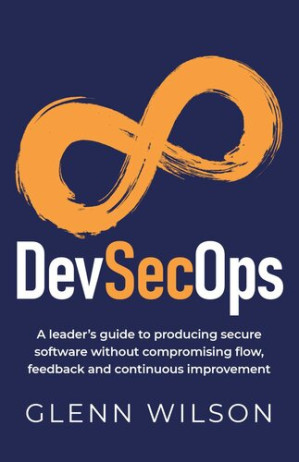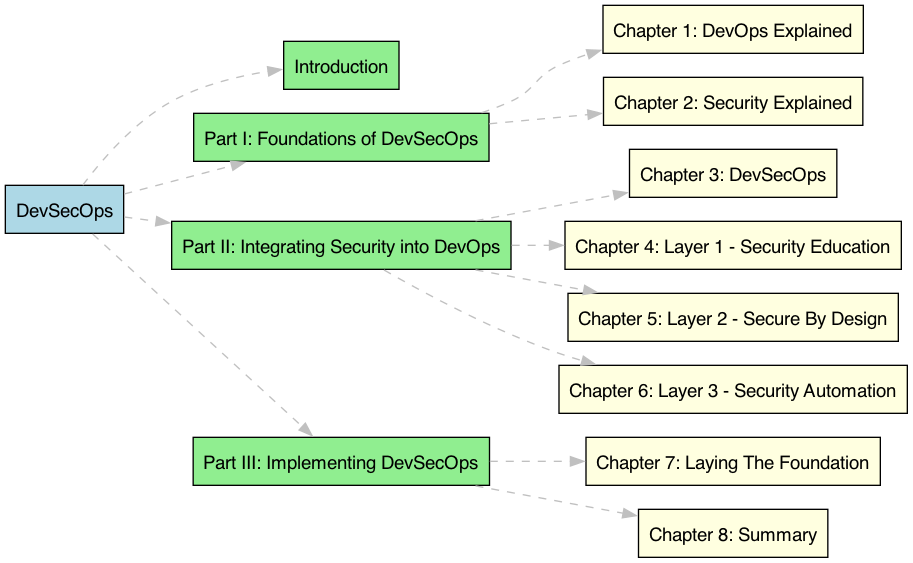Insights from DevSecOps
In the evolving landscape of software development, integrating security within the DevOps framework is crucial. Glenn Wilson's DevSecOps offers a comprehensive guide on how to embed security practices into DevOps, ensuring robust and secure software delivery. This book emphasizes a layered approach to DevSecOps, aiming to align security with agile and continuous delivery methodologies.

Summary

Part I: Foundations of DevSecOps
Chapter 1: DevOps Explained
Wilson begins by explaining the origins and principles of DevOps, highlighting its evolution from traditional waterfall methodologies to more agile, continuous delivery models. Key concepts include the three ways (left-to-right process flow, right-to-left feedback, and continuous improvement) and the five ideals (locality and simplicity, focus, flow and joy, improvement of daily work, psychological safety, and customer focus).
Chapter 2: Security Explained
This chapter delves into the importance of security in software development, outlining various types of attacks and adversaries. Wilson emphasises the CIA triad (confidentiality, integrity, and availability) as foundational security principles and discusses the challenges of integrating security into fast-paced DevOps environments.
Part II: Integrating Security into DevOps
Chapter 3: DevSecOps
Wilson introduces DevSecOps as an extension of DevOps that explicitly incorporates security. He discusses the challenges of integrating security engineers into DevOps teams and the necessity of embedding security practices within the development process rather than treating security as a separate, external function.
Chapter 4: Layer 1 - Security Education
This chapter focuses on the first layer of DevSecOps: Security Education. Wilson highlights the importance of continuous education in maintaining security awareness and skills within DevOps teams. He discusses various methods of delivering security education, including gamified learning, instructor-led training, self-paced learning, and pair programming.
Chapter 5: Layer 2 - Secure By Design
The second layer emphasizes the importance of incorporating security into the design phase. Wilson covers key design principles, such as threat modeling, clean code practices, and secure coding standards. He also discusses the role of microservices, container technologies, and securing the CI/CD pipeline.
Chapter 6: Layer 3 - Security Automation
Wilson explores the third layer: Security Automation. This chapter discusses the importance of automating security testing and monitoring within the CI/CD pipeline. Key topics include application security testing, mobile security testing, runtime application self-protection, and infrastructure as code testing.
Part III: Implementing DevSecOps
Chapter 7: Laying The Foundation
Wilson provides a roadmap for implementing DevSecOps in an organization. He emphasizes the need to increase DevSecOps maturity, reduce technical debt, introduce security education programs, implement security design principles, and integrate security test automation. He also discusses the importance of measuring and adjusting strategies based on feedback.
Chapter 8: Summary
The final chapter summarizes the key points of the book and reinforces the importance of embedding security within DevOps practices. Wilson highlights the necessity of a cultural shift towards continuous security improvement and the role of leadership in fostering this change.
Key Takeaways
- Three-Layered Approach: Wilson's three-layered approach to DevSecOps (Security Education, Secure By Design, and Security Automation) provides a comprehensive framework for integrating security into DevOps.
- Cultural Shift: Successful DevSecOps implementation requires a cultural shift within the organization, emphasizing continuous learning and collaboration between development, operations, and security teams.
- Automated Security: Automating security testing and monitoring within the CI/CD pipeline is crucial for maintaining security at the speed of DevOps.
- Proactive Security: Embedding security practices early in the development process (Secure By Design) helps mitigate risks and ensures robust software delivery.
Personal Reflections
Reading DevSecOps by Glenn Wilson has been enlightening, particularly in understanding the necessity of integrating security into every aspect of the software development lifecycle. Wilson's layered approach provides a practical framework for achieving this integration, emphasizing the importance of continuous education, good design principles, and automation. The emphasis on cultural change and proactive security measures resonates deeply with my experiences in the field.
Conclusion
DevSecOps by Glenn Wilson is an essential resource for any organization looking to enhance their DevOps practices with robust security measures. The book provides a clear and practical roadmap for integrating security into DevOps, ensuring that security becomes an integral part of the software development lifecycle. By adopting Wilson's three-layered approach, organizations can achieve a more secure and efficient software delivery process.